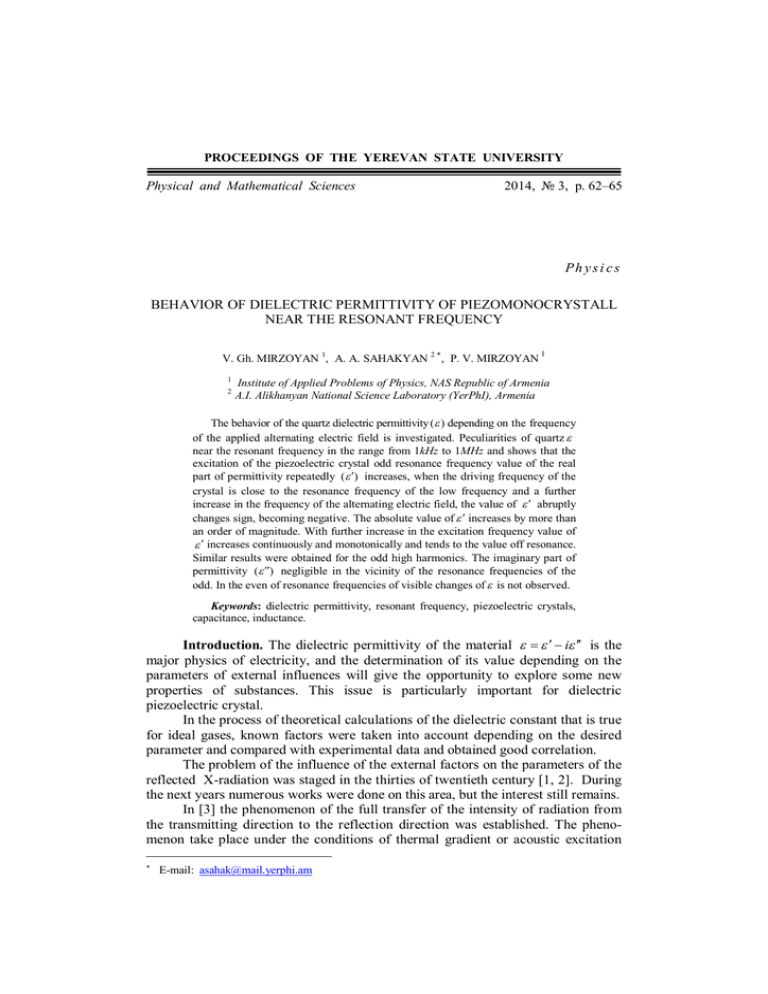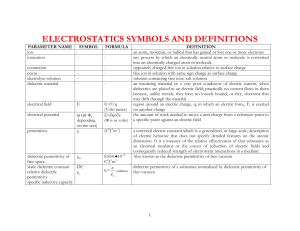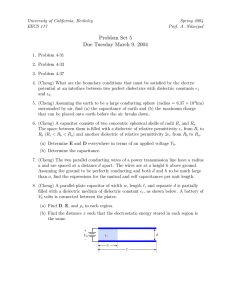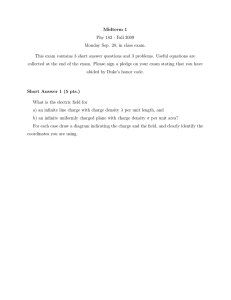Behavior of dielectric permittivity of piezomonocrystall near the
advertisement

PROCEEDINGS OF THE YEREVAN STATE UNIVERSITY Physical and Mathematical Sciences 2014, № 3, p. 62–65 Ph ysi cs BEHAVIOR OF DIELECTRIC PERMITTIVITY OF PIEZOMONOCRYSTALL NEAR THE RESONANT FREQUENCY V. Gh. MIRZOYAN 1, A. A. SAHAKYAN 2 , P. V. MIRZOYAN 1 2 1 Institute of Applied Problems of Physics, NAS Republic of Armenia A.I. Alikhanyan National Science Laboratory (YerPhI), Armenia The behavior of the quartz dielectric permittivity ( ) depending on the frequency of the applied alternating electric field is investigated. Peculiarities of quartz near the resonant frequency in the range from 1kHz to 1MHz and shows that the excitation of the piezoelectric crystal odd resonance frequency value of the real part of permittivity repeatedly ( ) increases, when the driving frequency of the crystal is close to the resonance frequency of the low frequency and a further increase in the frequency of the alternating electric field, the value of abruptly changes sign, becoming negative. The absolute value of increases by more than an order of magnitude. With further increase in the excitation frequency value of increases continuously and monotonically and tends to the value off resonance. Similar results were obtained for the odd high harmonics. The imaginary part of permittivity ( ) negligible in the vicinity of the resonance frequencies of the odd. In the even of resonance frequencies of visible changes of is not observed. Keywords: dielectric permittivity, resonant frequency, piezoelectric crystals, capacitance, inductance. Introduction. The dielectric permittivity of the material i is the major physics of electricity, and the determination of its value depending on the parameters of external influences will give the opportunity to explore some new properties of substances. This issue is particularly important for dielectric piezoelectric crystal. In the process of theoretical calculations of the dielectric constant that is true for ideal gases, known factors were taken into account depending on the desired parameter and compared with experimental data and obtained good correlation. The problem of the influence of the external factors on the parameters of the reflected X-radiation was staged in the thirties of twentieth century [1, 2]. During the next years numerous works were done on this area, but the interest still remains. In [3] the phenomenon of the full transfer of the intensity of radiation from the transmitting direction to the reflection direction was established. The phenomenon take place under the conditions of thermal gradient or acoustic excitation E-mail: asahak@mail.yerphi.am Mirzoyan V. Gh., Sahakyan A. A., Mirzoyan P. V. Behavior of Dielectric Permittivity... 63 for the thin crystalls and Laue geometry ( t 1 , where is the linear coefficient of absorption and t is the thickness of the crystall). In [4] the decreasing of the linear coefficient of absorption was obtained for the quartz crystall. The energy of the X-radiation was 17.47 KeV and the thermal gradient was applied perpendicularry to the reflecting atomic planes. The change of the linear coefficient of absorption for the quartz crystal, i.e. the total intensity of the reflected and transmitted beams in the Laue geometry, is 30%, which means the growth of the transparency of the crystal, because of the reduction of the linear coefficient of absorption. In [5] the authors gained almost complete transparency of the quartz monocrystall for the synchotron radiation with 17KeV energy. The absorbed intensity is 3.5% of the incident intensity. Without ultrasound this value is 50%. The aim of this work was to experimentally investigate the behavior of the dielectric permittivity of quartz near the resonance frequency. The frequency dependence of the quartz dielectric permittivity with resonant frequency 100 kHz in the frequency range from 1 kHz to 1 MHz was studied. It is found that far from the resonant frequency and the odd harmonics has a constant value, and near the resonant frequency and near the odd harmonics of a sharp change in the gap function with ( ) for an odd resonance frequency. In our experiment we have to deal with pezocrystallic anisotropic medium, where the dielectric constant is represented as a dielectric tensor ij and complicates the understanding of the physical processes occurring in crystalline media by an alternating electric field in the vicinity of the odd resonance frequencies. It is known, that ij symmetrical second-order tensor is defined by six variables. It should be noted that the real part of the dielectric permittivity for some materials takes a negative value. In [6] it is shown that the static dielectric permittivity of simple metals can be negative, and in [7] observed a negative dielectric permittivity in C70 fullerite films at frequencies of 0.1–10 kHz. Negative capacitance (impedance inductive type) is shown in silicon p+ – n– junction irradiated with fast electrons [8] and in homogeneous semiconductor structures [9]. Experimental Results. First we present the experimental results, we give a summary of the methods of measuring capacitance. Generator R R Frequency Counter DA Q “0” Ck Lock-in Amplifier Fig. 1. Block diagram of measuring installation: R=100 kΩ active resistance; Ck=10–110 pF variable calibrated capacity; Q is quartz resonator; DA is differential amplifier; “0” is zero indicator. The dielectric parameters of the sample silica having a rectangular shape with dimensions of 0.5×3.5×27 mm3 measured the bridge circuit shown in Fig. 1. As the upper arm of the bridge instead of the resistance R was used as the Proc. of the Yerevan State Univ. Phys. and Mathem. Sci., 2014, № 3, p. 62–65. 64 inductance value of conformance. In this case, too, were identical to the experimental results obtained. Position accuracy vessel was 0.05 pF, the amplitude of the sinusoidal AC voltage of the electric field on the sample was varied from 20 mV to 1 V. Fig. 1 shows a block diagram of a measuring system for the case, where the upper arm of the bridge resistances are set. All measurements were performed at room temperature. Over the entire frequency range (from 1 kHz to 1 MHz) dielectric characteristics were observed only in a narrow range of frequencies near the fundamental resonance frequency and odd harmonics, and even harmonics have a constant value. In the vicinity of the resonance frequency of a feature is observed an abrupt change in the sign and magnitude of . In the measurement of the frequency dependence in the forward (increased) and reverse hysteresis effects were not observed. Fig. 2. Frequency dependence of a quartz resonator dielectric permittivity near to resonance 100 kHz frequency. Fig. 2 shows the real part of the dielectric permittivity from the frequency of the alternating electric field. In this experiment the first resonance frequency of the quartz was 100 kHz. As can be seen from Fig. 2, at a frequency res ( res is the resonant frequency of the first harmonic of quartz) dielectric permittivity continuously increases monotonically by more than an order of magnitude, and provided res value of abruptly becomes negative. With further increase in the frequency of the alternating electric field, this value is increased and becomes equal to zero and further increases, and reaches its initial value. The data in Fig. 2 were obtained at the amplitude of the sinusoidal electric field of 50 mV. It should be noted that this dependence in the range from 20 mV to 1 V is not dependent on the amplitude of the electric field. Similar results were obtained for the high-order odd harmonics. For the even harmonics of the resonant frequency of quartz visible change is not observed and the function ( ) is constant and continuous. Mirzoyan V. Gh., Sahakyan A. A., Mirzoyan P. V. Behavior of Dielectric Permittivity... 65 The dielectric loss near odd resonances were minor. Identical results were obtained, when the block diagram of the measuring system resistances R replaced inductors. The experimental results were obtained as a monotonic increase with the exciting frequency of the applied electric field, and at this lower frequency compared to the resonance frequency. The dependence ( ) is independent of the direction of change of the excitation frequency. Conclusion. Since the dielectric permittivity is related to the polarizability of the medium, it is natural to assume that for odd resonance frequencies and polarizability changes by appropriate manner. From the above it follows that the objects piezomonocrystals are very sensitive to external influences, especially to the resonant excitations and the theoretical calculations of the physical processes that depend on the value of the dielectric permittivity and the polarizability is necessary to consider the results of the experiment described in this paper. Received 06.09.2013 REFERENCES 1. Fox G.W., Carr P.H. The Effect of Piezoelectric Oscillation on the Intensity of X-ray Reflections from Quartz. // Phys. Rev., 1931, v. 37, p. 1622. 2. Nishikava S., Sakisaka I., Sumoto I. Note on: The Effect of Piezoelectric Oscillation on the Intensity of X-ray Reflections from Quartz. // Phys. Rev., 1931, v. 38, p. 1078. 3. Mkrtchyan A.R., Navasardyan M.A., Mirzoyan V.K. The Transfer of Full X-Rays Diffracted from Monocrystals Passage Direction Reflection Direction under the Influence of the Temperature Gradient. // JTP Letters (Pisma v JTF), 1982, v. 8, p. 677–680 (in Russian). 4. Mirzoyan V.K., Noreyan S.N. Tezisi Dokladov Vsesoyuznogo Soveschaniya po Kogerentnomu Vzaimodestviyu Izlucheniya s Veschestvom. M., 1990, p. 142–143 (in Russian). 5. Mkrtchyan A.R., Mirzoyan V.K., Mkrtchyan A.G., Noreyan S.N., Kocharyan L.A., Sarkisyan K.A., Tonoyan V.U., Dovlatyan T.T., Vagner V., Prade G., Matz V., Shell N. ISTC Int. Conference. Yer., 2010, 4.1, p. 150–153 (in Russian). 6. Dolgov O.V., Maksimov E.G. On the Sign of Static Dielectric Permittivity of Simple Metals. // JETF Letters (Pis`ma v JTEF), 1978, v. 28, № 1, p. 3–6 (in Russian). 7. Makarov V.V., Sherman A.B. Low-Frequency Dispersion of Negative Dielectric Permittivity in C70 films // FTT, 2002, v. 44, № 11, p. 2101–2106 (in Russian). 8. Poklonsky N.A., Shpakovsky S.V., Gorbachuk N.I., Lastouski S.B. Negative Capacitance (Inductive Type Impedance) of Silicon p+−n-junctions Irradiated with Fast Electrons. // FTP, 2006, v. 40, № 7, p. 824–828 (in Russian). 9. Penin N.L. A Negative Capacitance in Semiconductor Structures. // FTP, 1996, v. 30, № 4, p. 626–634 (in Russian).





